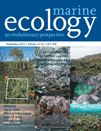Marine ecology as a framework for preparing the next generation of scientific leaders
Abstract
Across the United States there is increasing concern about the dwindling scientific workforce and the lack of students prepared for careers in the sciences. To build future leadership in this arena, we must employ innovative approaches that generate young peoples’ interest and develop their capabilities so that an increased number will pursue and be prepared for careers in scientific fields. Marine ecology is an ideal platform to engage young people in the sciences, develop their skills across multiple disciplines, and prepare them to face the complex challenges that lie ahead. In response, Ocean Discovery Institute, a non-profit organization, has developed Ocean Leaders, a model program to empower young people to become tomorrow’s scientific leaders. Using evaluation data that span the 5 years of the program, we asked how this model can affect participants’ interest and performance in science and how it can contribute directly to the field of marine ecology. Content assessments, surveys, interviews, and tracking data reveal that 73% of Ocean Leader students during this period have declared majors in science and conservation fields, scored higher on standardized science tests relative to their peers, and contributed to ecological research through 10 publications and more than 30 scientific presentations. Using a framework analogous to adaptive management strategies, key components of the program (including in-depth interactions with scientists and rigorous college readiness coursework) have been identified, resulting in an increased number of students who are interested in and ready to pursue science careers. Critical to this model is the partnership between scientists and a non-profit organization. Although this model may not easily be replicated in its entirety, aspects of this collaboration and the strategies employed can help to simultaneously advance the field of marine ecology and scientific leadership and understanding.
Children grow into tomorrow only as they live and learn today. Yet so complete has been the elimination of natural history from academe that there are virtually no teachers being trained to inspire and to mentor children from kindergarten through college…very few students are offered the opportunity of observing nature and accumulating the background natural history essential to the ecological understanding necessary to ask relevant questions.
P.K. Dayton 2003
Introduction
A dearth of emerging scientific leaders
During this century, the world’s investment in innovation, science, and technology has increased more than investment in any other area. Historically, the United States has been at the forefront of this expansion, with expenditures greater than the next three largest countries combined (National Science Board 2010). Currently, this commitment to science and technology is threatened as an aging workforce is not being replenished. Today, half of the scientific workforce in the United States is over 40 years old. One-quarter of the population is over 50 years old. By age 61, half of all scientists in the United States will no longer work full time but there is not a corresponding increase in degree production to fill future positions (National Science Board 2010). If the United States expects to participate in efforts addressing issues such as climate change, marine resource management, and shrinking energy reserves, more effective strategies are needed to encourage young people to pursue careers in the sciences.
To prepare a scientific workforce, science educators must use new strategies to spark students’ interest in science earlier, hold their interest throughout high school and college, and provide the resources and support they need to prepare for and succeed in college and the workplace. Unfortunately, evidence suggests that the United States is not adequately preparing the majority of its students for postsecondary study and careers in the sciences (National Science Board 2010, OECD 2010).
Scientific content in K–12 education in the United States is often diluted or subsumed in other subjects (Fortner & Mayer 1997) and little opportunity exists for students to connect the material they learn in K–12 science classrooms to larger contexts (Goodenough 2006). In a review of science standards across all 50 states by the Thomas B. Fordham Foundation and the Thomas B. Fordham Institute, over two-thirds of states received a grade ‘C’ or lower based on the level of clarity, rigor, and connection of individual standards to larger concepts (Finn et al. 2006). As a result, many college students consider science tedious and boring and do not pursue studies past the minimum requirements (Goodenough 2006).
Low performance in science threatens the position of the US in the global economy. Young people in the US perform more poorly on assessments of scientific knowledge compared with students in other countries. For example, the US ranked 17th out of 34 countries in the most recent international comparison of science knowledge among high school students, and had relatively few top performing students and many low performing students (PISA 2009). Overwhelmingly, students in the US are not adequately prepared to pursue college-level work in the sciences during their K–12 education.
Effective strategies to prepare scientific leaders
Fortunately, researchers have identified a number of factors associated with increased student interest and improved student performance in science. These factors include:
- 1
Early and continued exposure – Research has shown a relationship between early life experiences in the sciences and later career interests (Joyce & Farenga 1999). Repeated and continued exposure to the sciences is critical to assure that gains made in early childhood are not lost over time (Barnett 1995).
- 2
Engagement in authentic research – A growing body of evidence demonstrates that engaging students in authentic research plays a critical role in building self-efficacy or personal competency (see Bandura 1977, 1994) and in helping students who might not otherwise pursue post-secondary study envision themselves achieving such goals (Lee 1999; Markowitz 2004).
- 3
Interaction with practicing scientists – Student interactions with scientists have been shown to increase student confidence, interest, and understanding in science. These effects have been most pronounced in programs that include linkages with practicing scientists in real-world settings (Schenkel 2002; Farland-Smith 2009).
- 4
Hands-on learning – Integration of experiential, hands-on, project-based lessons is associated with students’ increased retention of scientific principles and content, increased interest and confidence in science, and increased ability to do science (Sevilla & Marsh 1992; Ornstein 2006). Inquiry-based science investigations also lead to higher reasoning abilities in non-native speakers (Gerber et al. 2001), who currently make up 21% of public school students in the US (Aud et al. 2010).
- 5
Field-based learning – Use of outdoor laboratories or ‘place-based science education’ has been associated with increases in student achievement, critical thinking, motivation, and environmentally responsible behaviors (Athman & Monroe 2004; American Institutes for Research 2005; State Education and Environment Roundtable 2005; Louv 2008).
Marine ecology as a platform to build our scientific leadership
Ocean science generally, and the marine ecology of the coastal zone in particular, provides an extraordinary vehicle for implementing these strategies to teach science, develop critical skill sets, and equip emerging leaders to face the challenges of tomorrow. Much of this results from the complex and dynamic physical and biological processes of the ocean, but also from the considerable human reliance on and interaction with coastal seas (Talley et al. 2003; Levin & Dayton 2010).
The ocean is a highly dynamic system, operating under forcing from physical to biological processes at a wide variety of spatial and temporal scales. In the coastal ocean, this complexity is compounded, as these forces have both a terrestrial and an aquatic origin. The task of the marine ecologist is to integrate these biotic and abiotic complexities into a predictive, holistic understanding of the ecosystem. Thus, by its very nature, marine ecology provides a platform from which educators can build student understanding of virtually any of the disciplines or sub-disciplines of chemistry, physics, biology, or geology, as well as more broadly honing critical thinking skills.
The intensity with which humans depend upon and interact with the marine ecosystem enhances the ability to use marine ecology as a lens through which to train future leaders. Forty-four percent of the world’s population lives within 100 km of a coastline, and that percentage is increasing annually (http://sedac.ciesin.columbia.edu/es/papers/Coastal_Zone_Pop_Method.pdf). Humans rely on the ocean for transportation, food, and recreation, and interact with the oceans directly (e.g. provision of protein) and indirectly (e.g. global climate change) in countless ways (Costanza et al. 1997; Dayton 1998; Carr et al. 2003). Further, using ocean science as a platform for teaching science capitalizes on the public’s inherent interest in the sea. Engaging students in marine ecology allows educators to involve students more broadly in the interactions between science, policy, and the public on a variety of spatial and temporal scales. Integrating across all of these disciplines requires that students not only develop their scientific skills but also think about policy, community, and leadership, both now and in the future.
Despite these compelling reasons for incorporating ocean science into education, the ocean is largely ignored in K–12 formal and informal curriculum (Cava et al. 2005). If integrated, the study of ocean science provides a compelling forum for students to experience all aspects of science within a locally relevant context, preparing them to pursue careers in a variety of scientific fields.
Case study: a program to build young leaders in marine ecology
The Ocean Discovery Institute (ODI), a non-profit organization based in San Diego, California, USA, has developed Ocean Leaders, a model program that integrates the strategies described above in order to empower young people to pursue higher education and careers in science. Ocean Leaders annually engages middle school, high school, and college age young people in a series of interconnected after-school and summer programs and support services. This initiative offers a pathway for underrepresented students to progress from secondary school through university to careers in science and conservation. Ocean Leaders provides these students with a comprehensive ocean science experience over multiple years. It includes programmatic components and support services to ensure that each student participant has the interest and capabilities to move forward in their education and career.
A critical aspect of Ocean Leaders is an 18-week intensive, research-focused education experience for high school students which takes place in San Diego, California, US, and Bahía de los Angeles, Baja California, Mexico. Students work alongside scientists to conduct marine science-focused field research in Bahía de los Angeles. This area has long been recognized as important for marine ecology research and has recently been declared a biosphere reserve because of its high biodiversity (Case & Cody 1983; Danemann & Ezcurra 2008.
Questions guiding this investigation
Ocean Leaders is in the 5th year of ongoing evaluation and modification. Given the findings to date, we ask what we can learn about empowering youth to pursue careers in the marine sciences. Specifically, how does the program affect participants’ (i) interest in science and (ii) performance in science; and whether and how does this work (iii) contribute to the field of marine ecology?
Material and Methods
Program design
Ocean Leaders seeks to engage and empower those underrepresented young people least likely to enter the sciences, including individuals who are of color, are of low socioeconomic status, and/or do not speak English as their first language. Economists have concluded that one of the most promising strategies to increase the size and quality of the scientific workforce in the US is to attract members of these groups (Chantilly 2001; George et al. 2001).
Students in Ocean Leaders spend several weeks in San Diego preparing for an intensive research experience. They study ocean science concepts and develop skills in the classroom, lab, and field. Following this preparation, the students spend 5 weeks at a field research station on the Sea of Cortez in Bahía de los Angeles, where they conduct marine science research projects alongside scientists from universities and government agencies. The students then return to San Diego, where they spend 3 weeks preparing presentations and posters that they present at community and professional scientific forums.
Each year, three major research projects are conducted. During 2010, these included an examination of the effects of wetland plant diversity on faunal community stability in the face of climate change; an analysis of the effectiveness of bycatch-reduction techniques in gillnet fisheries; and a study of the spatial scale and mechanisms of spatial trophic subsidy on food webs (Fig. 1).
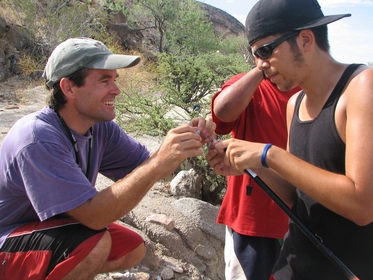
Dr. Gage Dayton (left) and high school students (right) collect data on reptiles. Ocean Leaders provides in-depth opportunities for students and scientists to work side-by-side.
In addition to science education experiences, students are provided with academic and personal support services throughout their middle school, high school, and college experiences that help ensure their progress toward post-secondary education and science-based careers. Because students of color from low socioeconomic status communities face multiple barriers, the support structure is extensive and includes services that promote academic success, college preparation, career exploration, and personal success (Fig. 2).
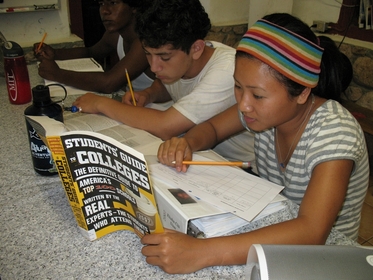
Students investigate colleges. Through Ocean Leaders support structure, students learn how to prepare for and overcome barriers on their path to college.
Because of the intensive resources provided to each participant, the program is designed to serve a small number of students and result in highly transformative impacts. A total of 56 students have participated in the Ocean Leaders high school research program during the past 5 years. Thirty-nine of these students participated for more than 1 year.
Evaluation design
To assess the effects of the program on individual students and identify potential improvements, evaluation is conducted annually. Before and after the program, each student takes a written science exam, completes a written survey, and participates in a one-on-one interview.
Program development
Evaluation results have been used to improve the program and to share promising practices with others. Through this process, the Ocean Leaders program design has evolved. Some of the enhancements to the program over the past 5 years have included:
- 1
Concept maps to identify and communicate the connections between research questions, methods, and results for each project. These conceptual frameworks are referred to frequently to develop in-depth understanding.
- 2
Regular didactic and non-didactic styles of testing to check for understanding of the research and immediately address gaps and misconceptions.
- 3
Multiple, multi-day lab- and field-based workshops led by scientists and linked to particular careers (e.g. biomechanics, molecular biology, geology) to provide students with the opportunity to engage with science and scientists across multiple disciplines.
- 4
Daily guest lectures from practicing scientists from a variety of fields of study, to increase students’ awareness of the range of science-related careers and connect the students’ research to a larger context.
- 5
Career seminars in academic and non-academic settings to foster career interests and help students envision themselves as practicing scientists.
- 6
Multi-tiered mentoring by students from a similar demographic, including peer-to-peer mentoring (Fig. 3) and a fellowship program to enable students to prepare for and envision themselves at the next level of their education and career development.
- 7
Rigorous support services that address barriers students face as they work toward academic, college, and career success. These have included the development of a 4-year scholarship to study the geosciences through a partnership with the University of San Diego and the National Science Foundation. (In other demographics these supports may be provided in other ways, such as parental involvement or high school counselors.)
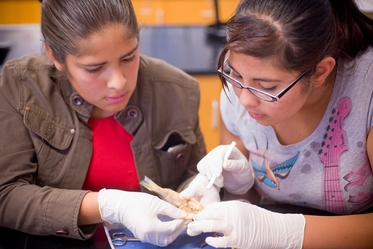
A mentor (left) helps a student (right) to conduct a fish dissection. Working with a mentor helps students to envision their path to college and careers in the sciences.
Research methods
We examined evaluation data across the 5 years of the program including scores on the pre- and post-written science exams, responses on pre- and post-written surveys, and in-depth qualitative analysis of pre- and post-one-on-one interviews. We also tracked information on high school performance, scores on standardized tests, and college attendance and declared major. Data were analyzed to assess student interest in science, interest in science and conservation careers, and understanding of scientific concepts and reasoning. To better understand the contribution of this model to the field of marine ecology, we looked at all data that were collected over the 5 years and tracked publications and presentations.
Results
Interest in science
Overall interest in science was maintained, with 100% of students expressing interest before and after the program during each of the 5 years.
During the 5-year period, students demonstrated increases and decreases in science career interest with an overall trend of increased understanding and interest in a greater breadth of science careers. In 2006, 67% of participants reported an interest in a science career before and after the program and there were no changes in students’ career choices or awareness. In 2007, students reporting career interests in science grew from 52 to 81%, with the increased interest exclusively in marine biology. In 2008, there was a decrease in the number of students reporting career interests in the sciences, with 90% interest pre-program and 75% interest post-program. However, 60% of the students who reported not being interested in science careers did not recognize their career interests (medicine and engineering) as science fields. In 2009, students’ career interests in science increased from 71% of students reporting interest in science careers pre-program to 86% post-program. In addition, 50% of students expressed interest in wider diversity of science careers in the post-interview. In 2010, 100% of students expressed interest in science careers both before and after the program. Sixty-four percent of these students demonstrated a greater understanding of science careers and the breadth of opportunities, expressing interest in a diversity of fields including ecology, geology, biomechanics, molecular biology, bioengineering, and nuclear science (Table 1).
| Year | Students reporting interest in careers in the sciences | Evidence of changes in sophistication | |
|---|---|---|---|
| Pre-program | Post-program | ||
| 2006 | 67% (10 of 15) | 67% (10 of 15) | Student interest in particular science careers was identical before and after the program |
| Program changes as a result of the 2006 evaluation: Instituted daily guest lectures by practicing scientists | |||
| 2007 | 52% (11 of 21) | 81% (17 of 21) | Six students expressed increased interest in science careers post-program, one in general science, the other five in marine biology |
| Program changes as a result of the 2007 evaluation: Maintained daily guest lectures while recruiting scientists from a wider range of disciplines and adding a component to each lecture that depicted a path to that career | |||
| 2008 | 90% (18 of 20) | 75% (15 of 20) | Four students expressed increased interest and five students expressed decreased interest in science careers post-program, all in general science and marine science. Three of the students reporting decreased interest did not recognize that their interests in medicine and engineering are part of science fields |
| Program changes as a result of the 2008 evaluation: Maintained daily guest lectures while piloting multi-day lab- and field-based workshops led by scientists and linked to particular careers | |||
| 2009 | 71% (10 of 14) | 86% (12 of 14) | Seven students expressed interest in a wider diversity of science and/or conservation careers post-program including ecology, conservation, field research, medical research, biochemistry, and ornithology |
| Program changes as a result of the 2009 evaluation: Maintained daily guest lectures while instituting and refining multiple, multi-day lab- and field-based workshops led by scientists (many of whom reflected the student demographic) and linked to a diversity of careers | |||
| 2010 | 100% (14 of 14) | 100% (14 of 14) | Nine students expressed interest in a wider diversity of science and/or conservation careers post-program including ecology, geology, oceanography, molecular biology, biomechanics, chemical engineering, computer science, astronomy, and nuclear science |
Of the program participants now enrolled in 4-year universities who have declared a major, 73% (22 of 30) have selected a major in the fields of science or conservation.
Performance in science
In each year of the 5-year period, students increased their performance on objective science tests from the beginning to the end of the program by an average of 20.5% (Fig. 4). After 2006, each year of the program included a minimum of 6% and maximum of 79% returning students.
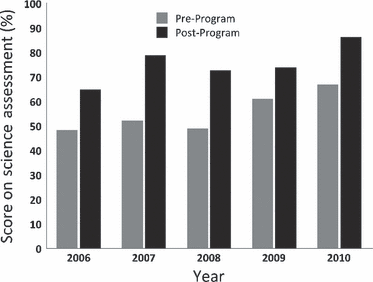
Performance of students on pre- and post-objective tests from 2006 through 2010. Students consistently performed better after involvement in the Ocean Leaders program (paired t test, t4 = 8.0, P < 0.01).
In 2008, a pilot interview question asked students to describe their research as an additional method of measuring understanding of science. In response, 61% of students (11 of 18) spoke proficiently about the scientific process. However, responses were almost identical between students, suggesting rote memorization rather than true understanding. In 2009, after implementing program enhancements to address this issue, students were presented with a novel scenario during interviews to test their understanding of the scientific process beyond rote memorization. Based on these responses, 79% of students (11 of 14) completed the program with increased understanding of the scientific process.
In 2009, we also began tracking the standardized science test scores of participating students and comparing them with non-participating students at the same high school. Eighty percent of Ocean Leaders students scored at ‘proficient’ or ‘advanced’ on standardized tests of life science knowledge compared with 16% of non-participants of the same cohort ( = 11.3, P < 0.01). In all, 38% of Ocean Leaders students scored at ‘proficient’ or ‘advanced’ on standardized tests of general science knowledge compared with 11% of peers from the same cohort (
= 11.3, P < 0.01). In all, 38% of Ocean Leaders students scored at ‘proficient’ or ‘advanced’ on standardized tests of general science knowledge compared with 11% of peers from the same cohort ( = 5.3, P < 0.05).
= 5.3, P < 0.05).
Contributions to marine ecology
Much of the fieldwork these students have performed relates to the earlier work of Polis et al. (1997) and Huxel et al. (2002). This research was started by Polis in Bahía de los Angeles in the late 1980s, focusing on understanding the effects of spatial subsidies on food web dynamics. With Polis’ death in 2000, this research program, and the long-term dataset that it generated, would have been discontinued after work was completed for the last funded grant. Instead, because of the added personnel, funding, and coordination through Ocean Leaders, data collection and new experiments have continued (Fig. 5). Through this program, we have been able to observe the impacts of marine trophic subsidy on insular ecosystems through multiple ENSO events, providing us with valuable information about the dynamics of the pathways and their effects on species diversity (F. Sanchez-Piñero, G. Huxel, D.M. Talley, S. Fisler, unpublished data), develop fisheries bycatch deterrents (Wang et al. 2010), and test questions about feedback loops in the land–sea food webs.
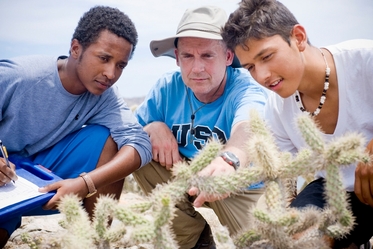
High school students work with Dr. Talley to continue and expand Dr. Gary Polis’ long-term research on land–sea interactions in Bahía de los Angeles.
This collaboration has provided us not only with years of additional data and experiments, but also with 10 publications (e.g.Fisler & Talley 2006; Talley et al. 2006; Wang et al. 2010), additional publications in preparation, more than 30 presentations at scientific conferences, and opportunities to provide input and interact with some of the leaders in the field of marine science. Our student-collected data were used by the Mexican government to support the establishment of the almost 400,000-hectare Bahía de los Angeles Biosphere Reserve in 2007 (Morzaria-Luna & Danemann 2008). Additionally, engaging in outreach and education has opened up avenues for funding (e.g. NSF Opportunities for Enhancing Diversity in the Geosciences, PADI Foundation, Marisla Foundation) that would not otherwise be available, and has helped scientists improve their ability to incorporate substantial ‘broader impacts’ in their science-based proposals.
Discussion
Building scientific leadership
The Ocean Leaders program has consistently developed students’ ability to implement research methods reliably and gain confidence through conducting field research. However, findings suggest that if this interest is to be translated into further study and be connected to pursuing science as a career, it is important that program elements incorporate experiences that go beyond implementing methods and equip students for higher level scientific thinking.
Interest in science
The students’ high interest in science pre-program is unsurprising, given that students often elect to enter the program based in part due to an attraction to science. It is encouraging that students maintain this high level of interest while participating in science at a much higher level, and with greater rigor, than they have previously experienced. In the future, it would be informative to investigate how the basis of this interest changes over time.
Throughout the 5-year period, student interest in science careers has become more sophisticated and specific following a series of program enhancements based on gaps identified through evaluation data each year (Table 1). This increased understanding of science careers and interest in a diversity of careers may be due to a broader exposure to practicing scientists from a variety of fields of study and the addition of hands-on experiences led by scientists and linked to particular careers and career paths (Table 1).
Initial data regarding major selection are promising, with 73% of Ocean Leaders participants choosing the sciences. This compares favorably to bachelor’s degrees earned across the nation. Approximately 33% of all degrees awarded in the US over the past 15 years have been in science and engineering (National Science Board, 2010). However, the results of several program enhancements made between 2008 and 2010, including peer-to-peer mentoring at multiple levels and support networks of program graduates on students’ campuses (see ‘Critical enhancements’ below), have yet to be documented, as these cohorts are just beginning to enter college. These enhancements may result in an increased number of students selecting science majors, persisting in these majors, and/or entering the scientific workforce.
Performance in science
A steady increase in scientific understanding by Ocean Leaders participants each year demonstrates that within each distinct year, students are learning science content. Although there was no positive trend in the magnitude of increases in understanding across years, this may be due to the fact that many students participated in the program for more than 1 year and therefore entered the program at a higher level and thus experienced smaller gains during their second year.
The increase in students’ ability to think critically and solve problems, rather than just repeat memorized information, is likely a result of targeted program enhancements, including providing a conceptual framework for student research, frequently conducting didactic and non-didactic tests of student understanding, and immediately addressing recognized gaps in knowledge.
While participants’ scores in science on standardized test were higher than non-participants at the same high school, a disparity exists between participants’ proficiency in life sciences and proficiency in other sciences. This demonstrates a need to increase science content and experiences across multiple disciplines during the program.
Critical enhancements
The overall framework on which this program is built is ‘adaptive engagement,’ which roughly corresponds to the ‘adaptive management’ concept used in natural resource management and restoration ecology (e.g.Walters & Holling 1990; Zedler & Callaway 2003). Here, the idea is to use the best science available to create a program, while iteratively testing, evaluating, and revising the program to increase success and add to our body of knowledge. Ocean Leaders uses a cycle of annual evaluation and revision as a tool to allow us to constantly assess and improve student performance and scientific accomplishments.
Building marine ecology
Engaging youth in marine science is a mutualistic activity, as the field of marine ecology benefits as well. Scientists receive tangible rewards including increased productivity, access to a broader range of funding, and an increased diversity of views and insights, as well as less quantifiable benefits such as psychological well-being (see Anik et al. 2009 and references therein). In this case study, young scholars have provided each of these benefits.
This is not to say that it is either easy or obvious how to effectively engage students in one’s research. Although there are some scientists who have the capacity to carefully and coherently integrate large numbers of students into their work, most probably cannot. This project has benefited greatly from the close partnership between academics and a science education non-profit organization, as well as support from the community, from the University of San Diego (at all levels), and from myriad donors and collaborators. Where that is possible, we would urge similar close ties, particularly those between professional educators and scientists. We nonetheless argue that even smaller-scale efforts to integrate individual students into research programs are not only possible but beneficial, both to the scientist and the public.
Conclusion
We are far from unique in seeing the connection between progress in the natural sciences and exposing youth to science and nature. Much of our work has been inspired by the philosophy of Paul K. Dayton. Since early in his career as a marine ecologist, Dayton has championed the idea that immersing oneself in nature and natural history is key to creating incisive, useful ecological discovery. The careful reader will see this idea woven through, for example, Dayton’s chapter on the challenges for the field of ecology (Dayton 1979), and will see it more explicitly in his recent work (Dayton & Sala 2001; Dayton 2003). This philosophy is one of the cornerstones of our integration of education, scientific research, and environmental stewardship that has resulted in the successes of this model.
Mutualistic relationships between education and science that include adaptive integration, authentic science experiences, and long-term support services can result in a tremendous impact on the targeted students. In the longer term, these relationships will reap large-scale benefits for the sciences as we not only build a citizenry that is scientifically and environmentally literate, but a workforce from which will spring new and fruitful research.
Acknowledgements
We would like to share our greatest appreciation to Paul K. Dayton for the mentorship he has provided to our researchers, ODI organization leaders, and the student participants directly. He has inspired the ideas that led to the program and outcomes described here, and continues to encourage and guide us toward greater scientific and social impacts each year. We thank the over 100 supporters who have provided funding to Ocean Leaders, including the Bank of America Foundation, Department of Education, Harriet E. Pfleger Foundation, Life Technologies, National Oceanic and Atmospheric Administration, National Science Foundation (NSF Grant #0914711), and REI. We also thank our many instrumental partners including the City Heights Educational Collaborative; Comisión Nacional de Áreas Naturales Protegidas; National Oceanic & Atmospheric Administration; Pronatura; Scripps Institution of Oceanography; University of California, San Diego, Academic Connections; and the University of San Diego. In addition, we would like to recognize our partnering and contributing scientists, including Lihini Aluwihare, Exequiel Ezcurra, Mark Denny, Sarah Gray, Miguel Guzman-Garcia, John Mendlein, John Pearse, Yonat Swimmer, Theresa Talley, John Wang, Zhi-Yong Yin, and many others. We would like to thank the staff and boards of ODI. This manuscript was greatly improved thanks to the comments of two anonymous reviewers. Finally, we acknowledge the student participants for embarking on discoveries that have generated great enthusiasm for science and inspired others to learn and do more.



